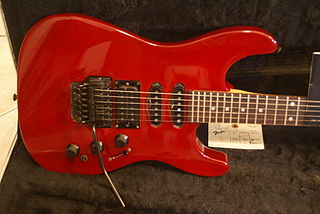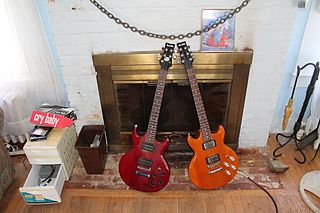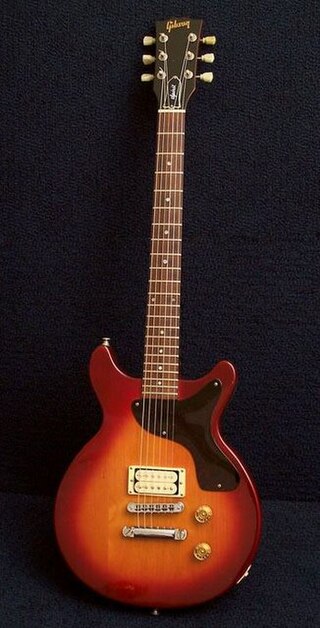Ibanez is a Japanese guitar brand owned by Hoshino Gakki. Based in Nagoya, Aichi, Japan, Hoshino Gakki were one of the first Japanese musical instrument companies to gain a significant foothold in import guitar sales in the United States and Europe, as well as the first brand of guitars to mass-produce seven-string and eight-string guitars. Ibanez manufactures effects, accessories, amps, and instruments in Japan, China, Indonesia, and the United States. As of 2017 they marketed nearly 165 models of bass guitar, 130 acoustic guitars, and more than 300 electric guitars. After Gibson and Fender, Ibanez is considered the third biggest guitar brand.

The Fender Showmaster is a discontinued model of electric guitar made by Fender, and is characteristic of a superstrat.

Superstrat is a name for an electric guitar design that resembles a Fender Stratocaster but with differences that clearly distinguish it from a standard Stratocaster, usually to cater to a different playing style. Differences typically include more pointed, aggressive-looking body and neck shapes with increased cutaways to facilitate access to the higher frets, an increased number of frets on the fingerboard, a contoured heel at the neck joint facilitating easier higher fret access, the usage of humbucking pickups, and locking vibrato systems, most commonly the Floyd Rose.
The Jackson Soloist is an electric guitar model introduced by Jackson Guitars in 1984, although prototypes were available before then. The design is a typical "superstrat"; it varies from a typical Stratocaster because of its neck-thru design; tremolo: Floyd Rose or similar, Kahler; or a fixed Tune-O-Matic; premium woods; a deeper cutaway at the lower horn for better access to the higher frets, and a sharper body with squared-off edges.

The Jackson Dinky is a Superstrat-style double-cutaway electric guitar built by Jackson Guitars. The "Dinky" is named for its slightly smaller than normal (7/8) body size. Usually fitted with a two humbucker pickup configuration, some models also include single-coil pickups and/or just one bridge humbucker. The fretboard can be made out of ebony, rosewood and more recently maple, or rock maple, with 24 jumbo frets and is always built with a bolt-on neck. Most of the guitars have a Floyd Rose original or licensed tremolo, and a locking nut to help maintain stable tuning. Some Dinkys have hardtail, or String-Thru bridges. The Jackson Dinky is usually preferred by players of hard rock and heavy metal.

The Ibanez MTM series was a series of signature guitars created by Slipknot's Mick Thomson, and produced by Ibanez. Some of the MTMs had the Ibanez RG shape and some had the Ibanez Glaive shape. They have two humbucking pickups, and the fixed Edge FX bridge, which is based on Ibanez Edge tremolo but fixed, providing more tuning stability than a standard hard-tail. Contrary to popular belief, the MTM series guitars do not have a tremolo bar or system. They came factory tuned to Drop B, a very low tuning that Slipknot used frequently. The MTM series was discontinued in 2016, when Mick Thomson switched to Jackson Guitars.

The Ibanez RG is a series of electric guitars produced by Hoshino Gakki. The first model in the series, the RG550, was originally released in 1987 and advertised as part of the Roadstar series. That series was renamed "RG" in 1992 and all models since are simply known as RGs.
The Fender Katana is an electric guitar built by Fender. It was designed by marketing director Dan Smith in 1985. The Katana was designed to compete with the unconventionally-shaped guitars of the era, such as the Jackson Randy Rhoads, and to satisfy Fender dealers who were suffering from the competition those instruments offered. The Katana did not sell as well as Fender hoped, and it was discontinued in 1986 before being reissued as a Masterbuilt Custom Shop model as part of the Prestige collection three decades later.
The Jackson Rhoads is a model of electric guitar, originally commissioned by guitarist Randy Rhoads and produced by Jackson Guitars.

The Ibanez JEM is an electric guitar manufactured by Ibanez and first produced in 1987. The guitar's most notable user is its co-designer, Steve Vai. As of 2010, there have been five sub-models of the JEM: the JEM7, JEM77, JEM777, JEM555, JEM333, and JEM70V. Although the Ibanez JEM series is a signature series guitar, Ibanez mass-produces several of the guitar's sub-models.
The ESP EX is a series of electric guitars produced by ESP produced in the United States, Europe and in Japan with the ESP logo as part of the ESP Original Series.

Fender Contemporary Stratocaster electric guitars were produced by Fender Japan in the 1980s.

The Ibanez Iceman is a guitar produced by Hoshino Gakki under the Ibanez brand.

The Ibanez GIO Series is an affordable guitar series produced by Hoshino Gakki (Ibanez), replacing the Cimar line. The GIO line is intended as beginner models, similar to Fender's Squier guitars, and Gibson's Epiphone line. This series of guitars are produced in either China or Indonesia, depending on model.
Fender California Series electric guitars were a type of Stratocaster produced by Fender in 1997 and 1998. The guitars were carved in California, shipped to Baja California Norte, Ensenada, Mexico for painting, then assembled in California.
The Fender Prodigy is a discontinued model of electric guitar produced by Fender from 1991 to 1993. It is one of Fender's attempts to compete with the superstrat-style guitars produced by Ibanez, Jackson/Charvel, Carvin Corporation and Yamaha. Since the Prodigy series was discontinued after about 2+1⁄2 years of production without a clear reason, it is considered one of Fender's rare models because of its limited production. Fender also produced a Prodigy Bass based on the Precision Bass Plus Deluxe featuring a P/J pickup layout (P as in Fender Precision Bass and J as in Fender Jazz Bass), 2-band active circuitry and a "fine-tuner" Schaller Elite bridge assembly.

The Gibson Spirit was a guitar model sold under Gibson and Epiphone USA nameplates in the 1980s. This article does not refer to the made-in-China Spirit guitar sold under the Gibson Baldwin Music Education nameplate.

The Ibanez Jet King is the term for a family of electric guitars sold by Ibanez. The family includes:
The Yamaha Corporation is a multinational corporation and conglomerate based in Japan with a wide range of products and services, predominantly musical instruments, motorcycles, power sports equipment and electronics.
The Fender Telecaster, colloquially known as the Tele, is an electric guitar produced by Fender. Together with its sister model the Esquire, it was the world's first mass-produced, commercially successful solid-body electric guitar. Its simple yet effective design and revolutionary sound broke ground and set trends in electric guitar manufacturing and popular music. Many prominent rock musicians have been associated with the Telecaster for use in studio recording and live performances, most notably Bruce Springsteen, Luis Alberto Spinetta, Keith Richards and George Harrison.












